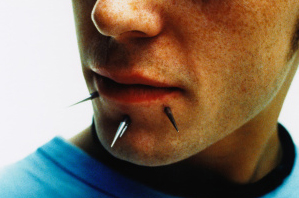 Oral piercings and piercings in general have become very popular in recent years. As a dental professional who works in a periodontal office I must strongly advise against all oral piercings as they can cause serious damage to your teeth and gums. Some of the documented complications with tongue piercings can actually lead to life threatening situations and the risk of serious infections is always present and very real.
Oral piercings and piercings in general have become very popular in recent years. As a dental professional who works in a periodontal office I must strongly advise against all oral piercings as they can cause serious damage to your teeth and gums. Some of the documented complications with tongue piercings can actually lead to life threatening situations and the risk of serious infections is always present and very real.
Most people do not even consider what happens or could happen to their oral health in the long term when getting a piercing in their mouth. The exact location of the piercing is dictated according to the outward appearance and not how it will affect the teeth and gums. If you have metal fillings or braces and the metal from your piercing makes contact with your metal dental work, it can actually create an electrical discharge or shock in your mouth! After a new oral piercing some people have problems with their speech and other embarrassing problems like drooling.
The oral piercing complication I will focus on for this article however is gum recession. Most oral piercings end up resting on or near the gum line inside the mouth, which creates a very high risk of gum recession.
Gum recession is when the gum’s soft tissue is literally worn away over time. Some people notice recession within a few weeks of having their oral piercing. Irreversible destruction to the soft tissue can happen as fast as six months or as slow as twenty-four months and in some cases the hard tissue (bone) can be affected as well. Tissue lost to recession will never grow back to its full thickness on its own.
The exact cause of gum recession with oral piercings is the barbell or disc shaped backing which is inside the mouth and is usually made of metal. As this metal piece makes contact with the gums it gradually wears or erodes the soft tissue away, making it thinner and eventually removing it all together which leaves the tooth’s vulnerable roots exposed. As recession has proven to be a serious and common complication of oral piercings, some of these discs now have a small rubber bumper on them so that the metal does not make direct contact with the teeth and others are made entirely of plastics like acrylic. This will not prevent gum recession; it will only slow it down a bit.
Is gum recession bad for me? Yes, the exposure of tooth roots is very dangerous to your oral health.
Exposed tooth roots not only look bad but they can cause hypersensitivity. Some people with gum recession have even reported that a cool breeze entering their mouth is all it takes to create a sharp and intense feeling of pain, imagine trying to enjoy an ice cold drink or a cup of coffee. It gets a lot more serious than just hypersensitivity though.
Tooth roots do not contain any enamel; this is the hardest substance in the human body which is found on the tooth’s crown surface only and is a natural defense against infections and decay. Exposed tooth roots are much more susceptible to collecting plaque which can lead to quick decay and complicate active gum disease infections. Gum disease and tooth decay are leading causes of tooth loss in people over the age of 35. Having a piece of metal in your mouth can even break or crack your teeth in the event of trauma, which is already the leading cause of tooth loss in people under the age of 35.
Once the gums have receded the teeth will start to erode next as they no longer have the gums to cover and protect them. The constant abrasion can eventually wear through the tooth’s root all the way into the tooth’s root canals. This would be extremely painful and lead to tooth loss.
I have gum recession, now what do I do?
First of all remove the oral piercing, the sooner the better. Gum recession is irreversible and can only be corrected with a surgical procedure commonly known as a gum graft, and clinically known as a connective soft tissue graft. See a periodontist like Dr. Silvera who specializes in the treatment of gum disease and correcting gum related problems like gum recession.
How exactly does a connective soft tissue graft work?
This surgical procedure takes soft tissue (the same tissue that your gums are made of) from the roof of your mouth; this soft tissue is then grafted onto the site of the recession as to completely cover the exposed tooth root. This procedure can be done under local anesthesia, is fairly quick, and initial healing takes about 24-48 hours. It can take anywhere from 4- 8 weeks on average for the tissue to completely heal and become part of your gums while also attaching to the tooth’s root surface with small connective ligaments. In some cases biological growth factors can be used to speed up the healing process as well as reduce swelling immediately after the surgical procedure. The end result is pretty amazing; I love how the human body can repair itself, in cases like this with some clinical intervention of course. I have assisted Dr. Silvera perform this procedure many times and when our patients have completely healed it is impossible to notice there was ever a problem at all.
Still think oral piercings are cool? ♥
